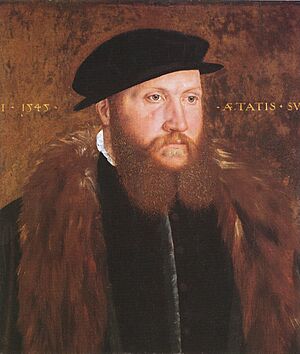John Bettes the Elder facts for kids

John Bettes the Elder was an English artist who painted between about 1543 and 1550. His most famous painting is a Portrait of a Man in a Black Cap. His son, John Bettes the Younger, was also a painter. He learned from a famous artist named Nicholas Hilliard. John Bettes the Younger painted portraits for Queen Elizabeth I and King James I.
We don't know much about John Bettes the Elder's life. Records show he lived in Westminster in 1556. He first worked for King Henry VIII at Whitehall Palace in 1531. Queen Catherine Parr paid him in 1546 and 1547. He painted miniature portraits of the King and Queen. He also painted six other portraits. For New Year's Day in 1547, Queen Catherine gave Prince Edward two portraits. These were of the King and herself.
Bettes also designed pictures for books. He designed the fancy border for the title page of William Cuningham's Cosmographical Glasse in 1559. He might also have designed pictures for Edward Hall's Chronicle in 1550. And perhaps a woodcut portrait of Franz Burchard, a Saxon ambassador, in 1560. A writer named John Foxe mentioned in 1576 that Bettes had already died. An earlier book from 1570 also said Bettes had passed away.
Finding His Paintings
We know which paintings are by John Bettes because of a special message. On the back of his painting Man in a Black Cap, it says: "faict par Johan Bettes Anglois". This means "done by John Bettes, Englishman." The painting itself is dated 1545 on the front.
Because of the style of this painting, experts believe four other portraits are also by Bettes. These include two paintings of Thomas Wentworth, 1st Baron Wentworth from 1549. There is also a portrait of Sir William Butts the Younger from around 1543. And one of Sir William Cavendish from about 1545.
His Painting Style
The way John Bettes painted Man in a Black Cap reminds people of Hans Holbein the Younger. Holbein was a very famous artist. This makes some people think Bettes might have worked with Holbein. However, we don't know much about Holbein's art studio. Holbein didn't seem to have a formal school for artists. Bettes is the only artist whose work clearly shows Holbein's painting methods.
For example, Bettes painted over a pink base layer, just like Holbein did. Art historian Roy Strong believes Bettes has the strongest claim to have worked with Holbein. But Bettes's style is also different. He painted fur more loosely than Holbein. He also painted beards more flatly. Art historian Susan Foister thinks that based on this portrait, Bettes probably didn't help Holbein directly.
It was rare for artists to sign their paintings during this time. The fact that Bettes added his nationality ("Englishman") might mean Man in a Black Cap was painted in another country. Over time, the blue background of the painting has turned brown. The painting has also been cut down on the sides and bottom. The original message was then reattached to the back. Some people think the portrait might be of Edmund Butts. He was the brother of William Butts, whom Bettes also painted. Both were sons of William Butts, a doctor for the royal court. Holbein painted a portrait of the elder William Butts in 1543.


